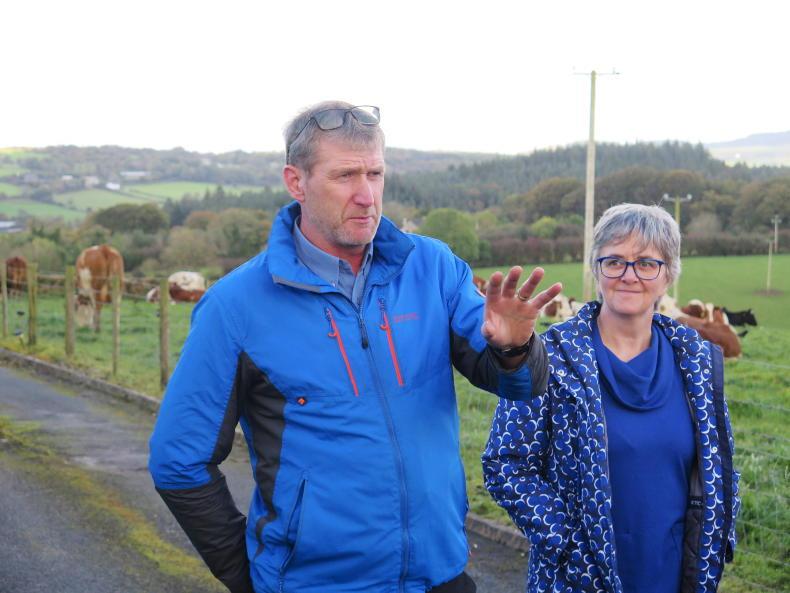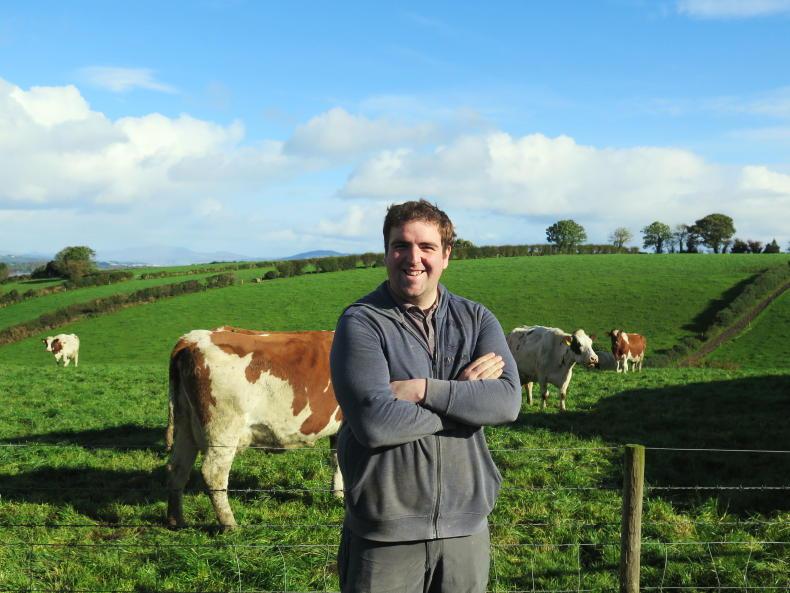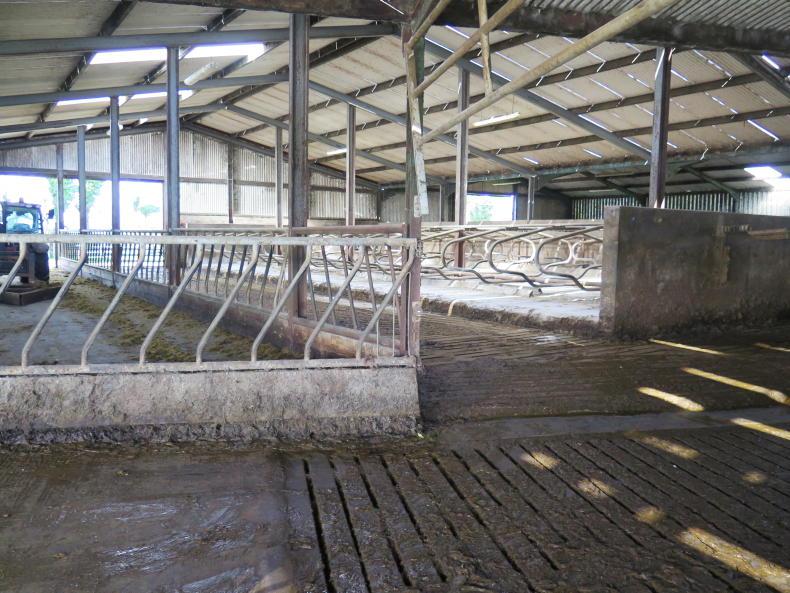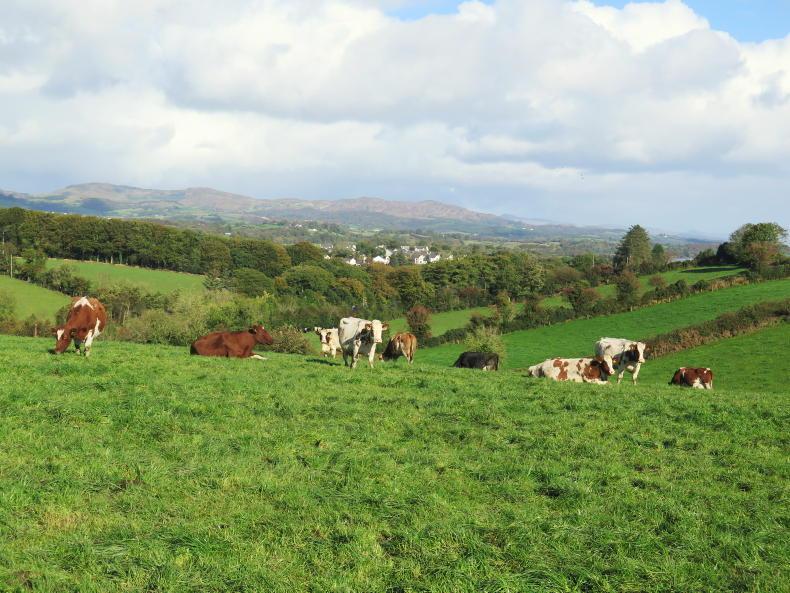Billy and Anne McMahon retired from farming and leased their 43ha farm to Chris Digimas at the end of 2019.
Visitors to last week’s Aurivo and Land Mobility farm walk at Ramelton in Co Donegal couldn’t but be impressed by the way they went about it.
Billy and Anne were milking 80 cows on a 30ha block of steep, but free-draining and fertile land.

Billy and Anne McMahon at their home in Donegal.
The standard of farming and the level of infrastructure on the farm was and is excellent. Their two grown-up children weren’t interested in farming, but it was Billy and Anne’s desire that the farm would carry on, even if they weren’t the ones farming it. Billy said they spent five or six years planning the process prior to retiring.
You really need to think more about what you’re going to do
“We didn’t arrive at the decision to lease out the farm overnight. We spent a few years thinking about it and planning it. You really need to think more about what you’re going to do, not what the person leasing the farm is going to do. Anne and myself worked hard as a team and we took the decision to retire as a team.”
The McMahons made contact with Austin Finn from the Land Mobility Service in 2018 but the process really only commenced in 2019.
Leasing the farm was most beneficial from a tax point of view and it is also very clean from a role and responsibility perspective.
Austin met the McMahons and after going through the various options the process to find someone to lease the farm commenced.
“We went to our database and we advertised the farm on the Land Mobility page of the Irish Farmers Journal and went through the applications.
“We talk a lot about the three Ps, the first is the person. They must have respect for the other party, be flexible and be willing to work with them to find a solution around problems. That’s true for both the landowner and person leasing the farm.
“The next is the period of the lease. This needs to be long enough and, generally speaking, a five-year lease is too short.
“Most of our agreements are 10 to 15 years. On this farm, the agreement is for a 10-year lease which works because the housing and infrastructure is excellent so the person leasing has no investments to make.
We hear of land going for much bigger money, particularly down south but that’s not sustainable
“Then comes the price. This has to be fair and workable. The person leasing the farm must be able to make a good return from it. Otherwise, problems will develop down the line. The farm owner also needs to get a return on the investments they’ve made. We generally talk in bands and a farm like this is in the €180/ac to €250/ac category.
“We hear of land going for much bigger money, particularly down south but that’s not sustainable. Paying €400/ac to €500/ac is simply not sustainable for the person leasing the land. Probably the biggest piece of work we have now is educating landowners on why that will not work out long term.”
Local man Chris Digimas was shortlisted. He was managing a farm in Claremorris, Co Mayo, and he had been building up equity in stock while working as a farm manager, which was a big help when it came to buying the cows off Billy and Anne.

Chris Digimas has been leasing the farm off the McMahons since February 2020.
“Before any agreement was signed, Billy visited the farm in Mayo to see the kind of operation that Chris was running.
“As soon as I drove into the yard, I was impressed. The yard was neat and tidy. The cows were in good order and grassland management was good. It gave me great confidence in Chris’s ability,” Billy says.
A deal was struck whereby the farm was leased to Chris for 10 years and he purchased all the cows on the farm. Cow numbers are now at 110, which is 3.6 cows/ha on the 30ha grazing block.
Billy spreads all the fertiliser on the farm, cuts the hedges and does odd maintenance jobs around the farm
Billy retained ownership of his tractor and most of the other machinery on the farm, but Chris purchased the loader and feeding equipment.
As part of the agreement, Billy spreads all the fertiliser on the farm, cuts the hedges and does odd maintenance jobs around the farm. Chris does the feeding and all other jobs are completed by the contractor.
Facilities on the farm are excellent, with 110 cubicles, an 11-unit modern milking parlour, good paddock and roadway infrastructure and, probably as importantly, all fields in the farm are index 3 and 4 for phosphorus, potassium and are on target for pH.
This is something Austin says can be a big problem on a lot of farms coming up for lease.

Facilities are excellent quality and very well maintained.
He says that, generally, farmers with no farming successor go on farming for too long.
“The first thing they’ll do is reduce the stocking rate to make life a bit easier but then grass gets harder to manage, so they cut back on fertiliser and stop reseeding. Before you know it, the ryegrass content on the swards has reduced and the farm gets run down.
“The next thing is, they start getting hip or back trouble as they age and work just becomes harder and harder because they’ve left things go too long.”
This is something that Anne and Billy wanted to avoid happening to them.
“We made the decision that we would continue to farm well, up until the last day. We want the agreement to work long term. It has to work for Chris and it has to work for us. We are very happy with the arrangement so far. It’s a complete package and we have a very good relationship with Christopher.
I’ve never been busier since I retired
“I look after the fertiliser, hedge-cutting and a few other jobs which I am very happy to do, but I am also very happy to do other things that I did not have time to do when I was farming full-time.
“I’ve never been busier since I retired. I got involved in things I didn’t have time to get involved in before. I work in a charity shop a few days a week, I cycled all of Ireland last year and cycled a lot of Scotland this year and also took up running.”
Motivation
“The reality is, we could have farmed for another 10 years but at that stage I wouldn’t be looking for a bike or a kayak – I’d be going for the armchair. It was a big motivation for me to retire at a time when I was fit and able to do the things that I wanted to do,” Billy says.
For a self-confessed perfectionist, the transition from being an owner-operator doing all the tasks himself to watching someone else do them can be difficult but this is something Billy was aware of and took steps to manage it.
For the previous three years before he retired, he got a student in for the spring. It wasn’t that he needed the extra help as such, more so that he wanted to get experience of others doing jobs that he would otherwise be doing himself and doing his way.
“It was a steep learning curve but it was very useful and probably the best thing I did to prepare myself for where I am today.
There are clear boundaries and we need to respect that
“When I signed the lease with Chris, I shook his hand and handed over the responsibility to him, but offered him support whenever he wanted it. There are clear boundaries and we need to respect that. It could be a serious pitfall if we weren’t clear beforehand on what is involved,” Billy says.
Chris Digimas is leasing a 43ha farm and milking 110 Fleckvieh/MRI cows.The farm is owned by Billy and Anne McMahon who retired from farming in 2020.Billy spent five or six years prior to retiring planning and thinking about the process.The arrangement works really well and was made possible by the Land Mobility Service.Billy continues to spread all the fertiliser, do the hedge-cutting and carry out routine maintenance on the farm. Billy and Anne farmed to a very high standard up to the day they retired.
Billy and Anne McMahon retired from farming and leased their 43ha farm to Chris Digimas at the end of 2019.
Visitors to last week’s Aurivo and Land Mobility farm walk at Ramelton in Co Donegal couldn’t but be impressed by the way they went about it.
Billy and Anne were milking 80 cows on a 30ha block of steep, but free-draining and fertile land.

Billy and Anne McMahon at their home in Donegal.
The standard of farming and the level of infrastructure on the farm was and is excellent. Their two grown-up children weren’t interested in farming, but it was Billy and Anne’s desire that the farm would carry on, even if they weren’t the ones farming it. Billy said they spent five or six years planning the process prior to retiring.
You really need to think more about what you’re going to do
“We didn’t arrive at the decision to lease out the farm overnight. We spent a few years thinking about it and planning it. You really need to think more about what you’re going to do, not what the person leasing the farm is going to do. Anne and myself worked hard as a team and we took the decision to retire as a team.”
The McMahons made contact with Austin Finn from the Land Mobility Service in 2018 but the process really only commenced in 2019.
Leasing the farm was most beneficial from a tax point of view and it is also very clean from a role and responsibility perspective.
Austin met the McMahons and after going through the various options the process to find someone to lease the farm commenced.
“We went to our database and we advertised the farm on the Land Mobility page of the Irish Farmers Journal and went through the applications.
“We talk a lot about the three Ps, the first is the person. They must have respect for the other party, be flexible and be willing to work with them to find a solution around problems. That’s true for both the landowner and person leasing the farm.
“The next is the period of the lease. This needs to be long enough and, generally speaking, a five-year lease is too short.
“Most of our agreements are 10 to 15 years. On this farm, the agreement is for a 10-year lease which works because the housing and infrastructure is excellent so the person leasing has no investments to make.
We hear of land going for much bigger money, particularly down south but that’s not sustainable
“Then comes the price. This has to be fair and workable. The person leasing the farm must be able to make a good return from it. Otherwise, problems will develop down the line. The farm owner also needs to get a return on the investments they’ve made. We generally talk in bands and a farm like this is in the €180/ac to €250/ac category.
“We hear of land going for much bigger money, particularly down south but that’s not sustainable. Paying €400/ac to €500/ac is simply not sustainable for the person leasing the land. Probably the biggest piece of work we have now is educating landowners on why that will not work out long term.”
Local man Chris Digimas was shortlisted. He was managing a farm in Claremorris, Co Mayo, and he had been building up equity in stock while working as a farm manager, which was a big help when it came to buying the cows off Billy and Anne.

Chris Digimas has been leasing the farm off the McMahons since February 2020.
“Before any agreement was signed, Billy visited the farm in Mayo to see the kind of operation that Chris was running.
“As soon as I drove into the yard, I was impressed. The yard was neat and tidy. The cows were in good order and grassland management was good. It gave me great confidence in Chris’s ability,” Billy says.
A deal was struck whereby the farm was leased to Chris for 10 years and he purchased all the cows on the farm. Cow numbers are now at 110, which is 3.6 cows/ha on the 30ha grazing block.
Billy spreads all the fertiliser on the farm, cuts the hedges and does odd maintenance jobs around the farm
Billy retained ownership of his tractor and most of the other machinery on the farm, but Chris purchased the loader and feeding equipment.
As part of the agreement, Billy spreads all the fertiliser on the farm, cuts the hedges and does odd maintenance jobs around the farm. Chris does the feeding and all other jobs are completed by the contractor.
Facilities on the farm are excellent, with 110 cubicles, an 11-unit modern milking parlour, good paddock and roadway infrastructure and, probably as importantly, all fields in the farm are index 3 and 4 for phosphorus, potassium and are on target for pH.
This is something Austin says can be a big problem on a lot of farms coming up for lease.

Facilities are excellent quality and very well maintained.
He says that, generally, farmers with no farming successor go on farming for too long.
“The first thing they’ll do is reduce the stocking rate to make life a bit easier but then grass gets harder to manage, so they cut back on fertiliser and stop reseeding. Before you know it, the ryegrass content on the swards has reduced and the farm gets run down.
“The next thing is, they start getting hip or back trouble as they age and work just becomes harder and harder because they’ve left things go too long.”
This is something that Anne and Billy wanted to avoid happening to them.
“We made the decision that we would continue to farm well, up until the last day. We want the agreement to work long term. It has to work for Chris and it has to work for us. We are very happy with the arrangement so far. It’s a complete package and we have a very good relationship with Christopher.
I’ve never been busier since I retired
“I look after the fertiliser, hedge-cutting and a few other jobs which I am very happy to do, but I am also very happy to do other things that I did not have time to do when I was farming full-time.
“I’ve never been busier since I retired. I got involved in things I didn’t have time to get involved in before. I work in a charity shop a few days a week, I cycled all of Ireland last year and cycled a lot of Scotland this year and also took up running.”
Motivation
“The reality is, we could have farmed for another 10 years but at that stage I wouldn’t be looking for a bike or a kayak – I’d be going for the armchair. It was a big motivation for me to retire at a time when I was fit and able to do the things that I wanted to do,” Billy says.
For a self-confessed perfectionist, the transition from being an owner-operator doing all the tasks himself to watching someone else do them can be difficult but this is something Billy was aware of and took steps to manage it.
For the previous three years before he retired, he got a student in for the spring. It wasn’t that he needed the extra help as such, more so that he wanted to get experience of others doing jobs that he would otherwise be doing himself and doing his way.
“It was a steep learning curve but it was very useful and probably the best thing I did to prepare myself for where I am today.
There are clear boundaries and we need to respect that
“When I signed the lease with Chris, I shook his hand and handed over the responsibility to him, but offered him support whenever he wanted it. There are clear boundaries and we need to respect that. It could be a serious pitfall if we weren’t clear beforehand on what is involved,” Billy says.
Chris Digimas is leasing a 43ha farm and milking 110 Fleckvieh/MRI cows.The farm is owned by Billy and Anne McMahon who retired from farming in 2020.Billy spent five or six years prior to retiring planning and thinking about the process.The arrangement works really well and was made possible by the Land Mobility Service.Billy continues to spread all the fertiliser, do the hedge-cutting and carry out routine maintenance on the farm. Billy and Anne farmed to a very high standard up to the day they retired. 









 This is a subscriber-only article
This is a subscriber-only article










SHARING OPTIONS: